Can Fire Insurance Manage Wildfire Risks in California?
The state's wildfire conundrum: overgrown forests, climate change, and more people living in the woods
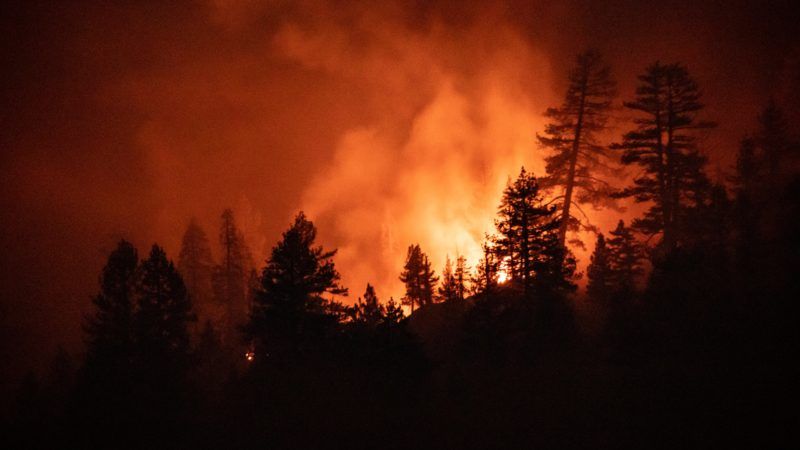
In California, wildfires have burned more than 3.2 million acres—an area larger than the state of Connecticut—since January. Since August 15, the state's fires have killed at least 24 people and destroyed more than 4,200 structures. The amount of the state's forestland that has burned this year is has been described as "unprecedented" and "record-breaking."
The area annually burned by wildfires has been zig-zagging upward since 1950. The chart below displays data through 2017; subsequently, Cal Fire reports, the wildfires consumed 1.6 million acres in 2018 and 260,000 in 2019 respectively.
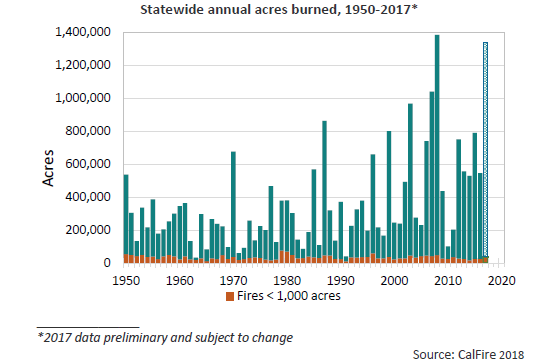
The latest area burned may not be as unprecedented on a longer time scale. For example, a 2007 study in Forest Ecology and Management suggests that the area in California burned by Native Americans to manage landscapes, as well as those sparked by lightning before the era of European settlement and active fire suppression, may have fallen between 4.5 and 12 million acres annually. "The idea that US wildfire area of approximately two million hectares (about 5 million acres) annually is extreme is certainly a 20th or 21st century perspective," wrote the researchers. "Skies were likely smoky much of the summer and fall in California during the prehistoric period."
In the 20th century, the National Interagency Fire Center reports that the area annually burned by wild land fires in U.S. (not just California) may have exceeded 50 million acres in 1930 and 1931. But the agency cautions that the less rigorous methods for collecting and compiling these early 20th century data means that "figures prior to 1983 should not be compared to later data." For example, the data from the 1930s may well include fires intentionally set in the Southeast to clear agricultural land.
A 2009 study in Ecological Applications (data updated here) identified a U-shaped trend in 11 western U.S. states, in which fires burned more space at the beginning of the last century, less in the middle decades, and more again recently:
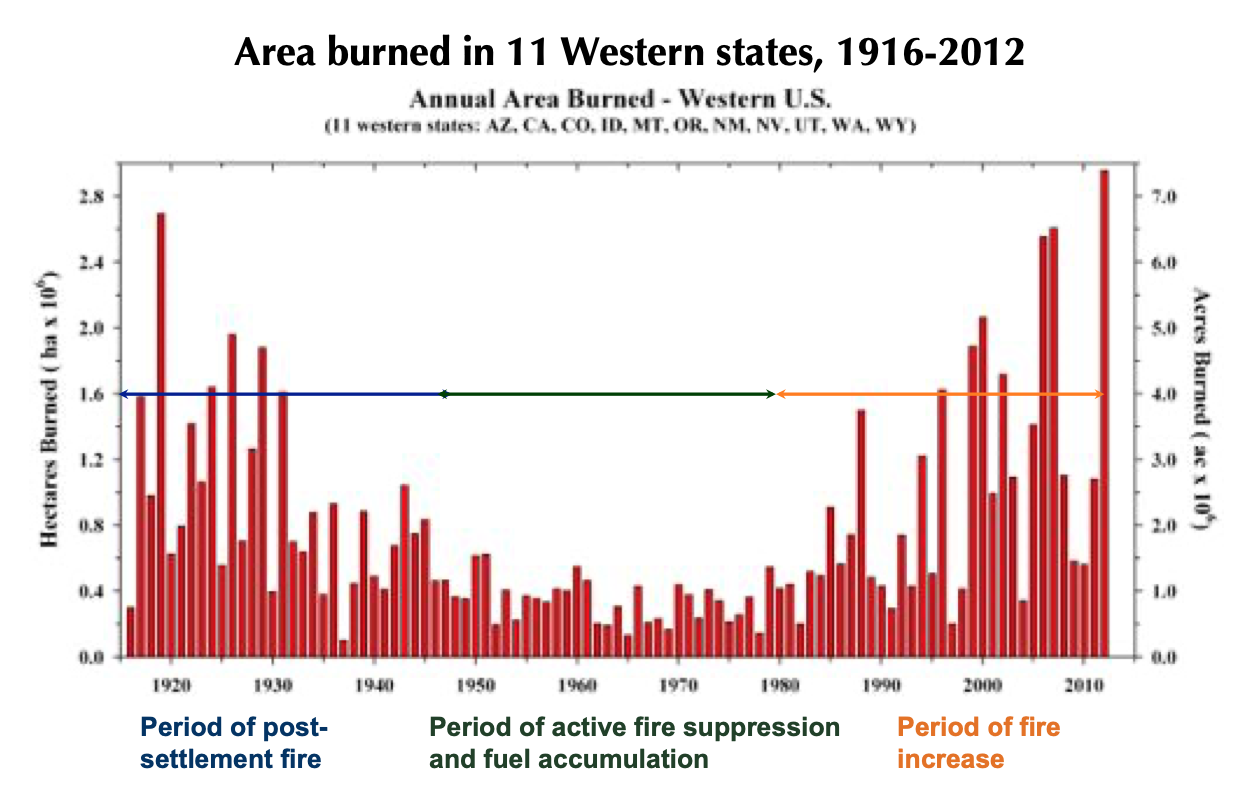
What is causing the upward trend in the area burned by wildfires in the western U.S.? During a visit to California this week, President Donald Trump suggested that bad forest management is the chief cause. During the briefing, California Gov. Gavin Newsom gingerly suggested that "the science is in and observed evidence is self-evident that climate change is real, and that is exacerbating this." In fact, both have played a role, as has the complicating circumstance that millions of Californians have moved to fire-prone wildlands.
A 2009 report from researchers associated with California Polytechnic State University observed that bad forest management, including active fire suppression and restrictions on timber harvests, have "resulted in an unnatural accumulation of fuels on many California forestlands." The report further noted: "Where 50–70 trees per acre stood before the Gold Rush, California forests now average over 400 trees per acre. When fire enters these ecosystems the resulting high-intensity wildfires are as unnatural as the accumulated fuels that they consume."
Meanwhile, California's climate has been heating up and periods of drought have been deepening and lengthening. Using surface temperature data, a team led by University of Maryland atmospheric chemist Clark Weaver calculates that California, since 1895, has been growing warmer at a rate of about 2.1° Fahrenheit per century. The warming sped up over that time: From 1960 to today, the rate is 4.8° per century.
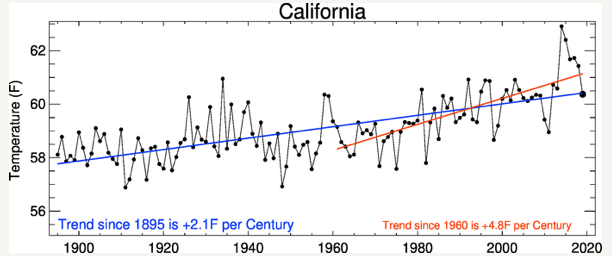
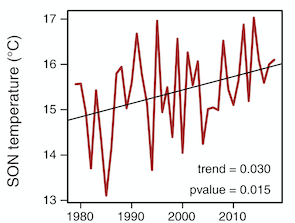
An August 2020 study in Environmental Research Letters finds that since 1979, a combination of rising temperatures and falling average precipitation has increased the likelihood of extreme autumn wildfire conditions across California. The researchers report trends for the months of September, October, and November (SON) in both temperatures (up about 1° Celsius) and precipitation (down an average of 30 percent), making fire weather conditions about twice as worse statewide.

The researchers find that from 1984 to 2018, the trends toward a hotter and drier California temperature correlate with a increase of about 40 percent per decade in the size of the statewide autumn-burned area.
As all this was happening, more people were heading into the woods, that is, making their homes in the "wildland-urban interface" (WUI) areas where houses and wildland vegetation meet and intermingle. Some go there because they can't afford to live in pricey urban areas with strict restrictions on new building, while other, more fortunate people move to the woods to enjoy the scenery, wildlife, and outdoor activities.
A 2007 report in the International Journal of Wildland Fire found by 2000, some 3.5 million California housing units were located in WUI areas, with another 1.5 million intermixed within and surrounded by wild landscapes. On top of that, 62 percent of net California housing growth from 1990 to 2000 occurred in WUI zones. A 2018 study in the Proceedings of the National Academy of Sciences reported that America's wildland-urban interface "grew rapidly from 1990 to 2010 in terms of both number of new houses (from 30.8 to 43.4 million; 41% growth) and land area (from 581,000 to 770,000 km2; 33% growth), making it the fastest-growing land use type in the conterminous United States."
In other words, more and more Americans have moved into areas where the wildfire risk is higher:
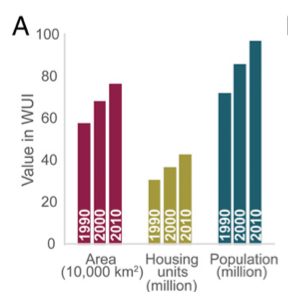
The measure that could make a big difference with respect to California wildfire risk is, as the president advised, better and more proactive forest management. As it happens, the federal government, which the president oversees, owns 57 percent of California's forests, whereas state and local governments own around 3 percent. (The rest is in private hands.)
Better forest management to reduce wildfire risk chiefly involves reducing the fuel load in overgrown fire-suppressed forests using mechanical harvesting and prescribed burns. A 2019 Government Accountability Office report found that federal agencies spent around $5 billion on reducing wildland fuels from 2009 to 2018:
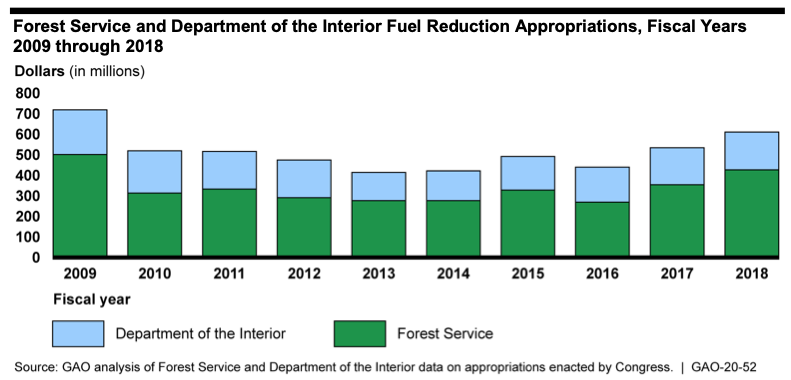
The Forest Service and the Bureau of Land Management estimate that more than 100 million acres of federal lands are at high risk from wildfire, but in 2018 the agencies managed to treat only about 3 million acres.
An intriguing 2019 study in Fire notes that 70 percent of all prescribed fire between 1998 and 2018 was completed by non-federal entities in the Southeastern U.S. In other words, private owners and state agencies in the Southeast have completed more than twice as much prescribed fire as the entire remainder of the country. "This may be one of many reasons why the Southeastern states have experienced far fewer wildfire disasters relative to the Western U.S. in recent years," the researcher observes. It is worth noting that the federal government owns just a small percentage of the land in most Southeastern states.
A 2020 study in Nature Sustainability estimated that 20 million acres of California forestland—about 20 percent of the state's land area—would benefit from prescribed burning to cut the risks of catastrophic wildfires. Yet California intentionally burned just 50,000 acres in 2017. The costs for prescribed burns range from $100 to $500 per acre. That suggests that it would take roughly $2 billion to $10 billion to treat 20 million acres. For comparison: In its latest budget request, the U.S. Forest Service says it has a backlog of 80 million acres in need of active management but plans to reduce fuel loads on just over 1 million acres in 2021. The U.S. Department of Agriculture, which oversees the Forest Service, suggested in a July 2020 report that "restoration of national forests comes with an estimated price tag of $65 billion."
The insurance risk analytics firm Verisk assesses the primary factors that contribute to wildfire risk—fuel, slope, and road access—to determine a property's individual wildfire hazard score. The company finds that more than 2 million properties in California are at high and extreme risk from wildfire. (Nationwide, about 4.5 million properties are at high wildfire risk.) The Insurance Information Institute reports that annual insured wildfire losses in the U.S. generally hovered below $1 billion from 2004 until 2017. In 2017 and 2018, insured wildfire losses escalated to around $15 and $17 billion, respectively, before dropping back down in 2019 to around $1 billion. U.S. insured wildfire losses so far this year are estimated at around $3 billion:
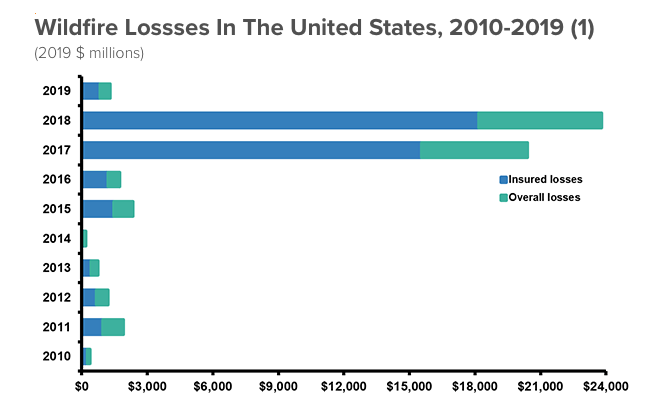
After the spectacular wildfire losses in 2017 and 2018, insurance companies have revised their risk models and are now pulling out the California market. Why? Because the premiums that state regulators allow insurers to charge don't cover their projected wildfire risks. By one calculation, insurers covering California wildfire losses paid out more than $2 for every $1 in premiums in 2017 and $1.70 for every $1 in premiums in 2018. With that dynamic, it is not surprising that insurance companies have dropped wildfire coverage for nearly 350,000 California homeowners since 2015. Property owners who can still buy insurance in the market have seen their premiums increase recently by as much 300 to 500 percent.
In the wake of 2018's disastrous fires, the California legislature passed Senate Bill 824, which prohibits cancellation or nonrenewal of homeowners policies within a year of a declared state of emergency if a structure is either in an area where a wildfire occurred or adjacent to a fire perimeter. In December 2019, California Insurance Commissioner Ricardo Lara imposed a mandatory one-year moratorium on insurance companies refusing to renew certain policies; this applies to least 800,000 homes in California wildfire disaster areas.
As more Californians lose their standard wildfire insurance coverage, they have been turning to the state's Fair Access to Insurance Requirements (FAIR) plan to protect their properties. The FAIR plan is basically a high-risk insurance pool that offers last-resort, bare-bones coverage, chiefly for fire losses, to property owners who cannot obtain a policy in the regular market. It was established in 1968, in the wake of urban riots and brush fires, when the California legislature required insurance companies offering property policies in the state to create and contribute to the plan. It is not taxpayer-financed, and plan premiums are statutorily required to be actuarially sound.
The FAIR plan's premiums have been increasing at a rate of 8 percent per year since 2016. This year, the program got regulators' permission to raise its rates by 15.6 percent—after trying to hike them by 35 percent.
Being unable to obtain insurance means, of course, that owners will find it much harder to sell, since banks will not issue mortgages for uninsurable properties.
Recognizing that his one-year nonrenewable mandate forcing insurance companies to maintain fire policies is coming to its end, Insurance Commissioner Lara announced this week that he is convening an investigatory hearing in October that will focus on ways to protect California residents against increasing wildfire risks. "Our current reality of increasing insurance premiums and non-renewals hurts those who can least afford it, including working families and retirees on fixed incomes," said commissioner Lara in a press release. "We can lower the insurance risk by incentivizing people to bring down the fire risk on their properties and in their communities with clear, science-based home-hardening standards."
Home-hardening could help, but not perhaps as much as the commissioner and property owners may think. A 2019 Fire article analyzed the factors associated with structure loss in the California areas burned by wildfire from 2013 to 2018. Analyzing how more than 40,000 structures exposed to wildfire fared, the researchers found that "in most regions home structural characteristics are far more important in determining home survival than defensible space." (Defensible space generally means cutting back brush and trees as much as 100 feet to establish a perimeter around a house.) They added that many "destroyed structures could be characterized as 'fire-safe,' such as having >30 meters of defensible space or fire-resistant building materials."
So why would one of the most frequently referenced protection measures—expanding defensible space—have so little impact on whether a house survives a wildfire? Because flying embers that precede the fire front by a mile or two often waft over the cleared perimeter to set houses alight. Measures that do somewhat increase the chances that a house will survive a wildfire are having enclosed (or no) eaves, multiple-pane windows, and screened vents. These tend to exclude embers from gaining entry into more combustible parts of a structure.
If this study is right, the home-hardening measures that commissioner Lara wants insurance companies to take into account when setting premiums will probably not have much impact on whether Californians who live in fire-prone areas can obtain coverage or reduce what those who can get coverage pay for their policies.
Whatever is sparking the upsurge in wildfires, California regulators and residents should take market signals seriously when deciding where to live. As the Pomona College environmental historian Char Miller recently put it in The New York Times, insurance companies ask themselves: "Why am I insuring something that I know is going to be destroyed?" Homeowners should certainly be asking themselves a similar question.
Meanwhile, a 2007 analysis in the Journal of Real Estate Finance and Economics found that repeated fires in any given area of Southern California brought down property values. "The first fire reduces house prices by about 10 percent," they calculated, "while the second fire reduces house prices by nearly 23 percent." Both insurance rates and resell prices are signals that living in the woods is costly. Many people may be willing to take the risk of losing their property to wildfire, but insurance policyholders or taxpayers should not be forced to subsidize that choice. Charging people the full cost of their fire risks could well incline them to build and live in safer areas.
A fascinating 2016 Stanford Law Review article highlights that point. The authors, legal scholars Omri Ben-Shahar and Kyle Logue, observe that insurance can serve "as a form of private regulation of safety—a contractual device controlling and incentivizing behavior prior to the occurrence of losses." Their focus is on flood insurance, but the point is valid for fire coverage too:
In the U.S., insurance is denied its potential role as an efficient regulator of pre-storm conduct. It does not induce rational precautions by individuals, cost-justified community development by localities, or efficient infrastructure investment. American insurance fails to achieve these straightforward and enormously important roles for a reason that can be stated in one sentence: insurance policies for weather related losses are not priced to reflect the real risk. As a result of government intervention in property insurance markets, through either rate regulation or direct government provision of subsidized insurance, private markets no longer generate prices signals regarding the cost of living in severe weather regions. The cost of insurance is suppressed, thus failing to alert private parties who purchase property insurance to the true risk of living dangerously. It allows these private parties to (rationally) assume excessive risk, and dump the cost of living in the path of storms on others. Indeed, much of the development of storm-stricken coastal areas is due to insurance subsidies, and would likely not have happened at the same magnitude otherwise.
Insurance could contribute at least modestly toward mitigating California's rising wildfire risks. Although it is way too bureaucratically complex and slow, the Federal Emergency Management Agency (FEMA) has a severe repetitive loss program hints at a way forward. That voluntary program buys out homeowners whose property has been flooded numerous times and encourages them to relocate to higher ground. FEMA has acquired more than 43,000 such flood-prone properties since 1989. A streamlined buyout program for structures destroyed by wildfire, ideally run by private insurers, could give residents of high-risk areas a stronger incentive to relocate and rebuild elsewhere.
One preliminary idea, based on what has been happening with many FEMA buyouts, is that insurers might pay the pre-fire value for burnt-out properties and communities, then turn the now-vacant land over to local land trusts to oversee and manage.
Another innovative measure that would help homeowners reduce their wildfire risks is to issue forest resilience bonds (FRBs). These raise private capital to fund forest restoration efforts, such as mechanical harvesting and prescribed burning, that reduce the chances of wildfire. Smaller fires mean lower costs. The bond issuers—who could be government entities, but could also be utility companies or other private parties—reimburse the investors over time. For example, a $4.6 million FRB was issued in 2018 to treat and lower the fire risks on 15,000 acres of forestland in the North Yuba River watershed via tree thinning and prescribed burning. Instead of waiting for action and fickle funding from distant federal and state agencies, local communities at high risk of wildfire could issue such bonds and begin forest restoration sooner. Insurance companies might even invest in such bonds, and could also factor the lower fire risk into their premiums for that community's homeowners.
An alternative to state and federal wildfire suppression is privately provided wildfire fighting. The Montana-based Wildfire Defense Systems (WDS) has been offering just such services since 2013. Insurance companies contract with WDS to evaluate the wildfire risks of policyholders and advise them on how to lower those risks. WDS also offers insurers access to private firefighting services that are on-call across 20 states.
The Trump administration is right to complain about poor forest management, but it has been offering no credible plans for fixing it. And California's insurance regulators seem dead set on policies that will eventually drive private insurance companies out of the state. Meanwhile, forests burn, thousands flee their homes, and millions choke on smoke.
Editor's Note: As of February 29, 2024, commenting privileges on reason.com posts are limited to Reason Plus subscribers. Past commenters are grandfathered in for a temporary period. Subscribe here to preserve your ability to comment. Your Reason Plus subscription also gives you an ad-free version of reason.com, along with full access to the digital edition and archives of Reason magazine. We request that comments be civil and on-topic. We do not moderate or assume any responsibility for comments, which are owned by the readers who post them. Comments do not represent the views of reason.com or Reason Foundation. We reserve the right to delete any comment and ban commenters for any reason at any time. Comments may only be edited within 5 minutes of posting. Report abuses.
Please to post comments




Another reason private owners take better care of the forests is that only the federal government can have it's mitigation efforts stalled for years by lawsuits from environmental terrorists.
I quit working at shoprite and now I make $65-85 per/h. How? I'm working online! My work didn't exactly make me happy so I decided to take a chance on something new…SOn after 4 years it was so hard to quit my day job but now I couldn't be happier.
Here’s what I do…>> CashApp
"Can Fire Insurance Manage Wildfire Risks in California?"
Sure, as long as the government doesn't subsidize it so it ends up under priced.
The opposite is true right now. California makes it so expensive and difficult to thin trees on private property that it just doesn't get done. Right now, the price of lumber is too low to make a profit from it, but it would at least come close to breaking even if the state didn't put so many obstacles in the way.
That would depend on where one lives. I removed over two dozen trees from my parcel without anybody's permission. In fact, I had the blessing of the local Fire Safe Council. On the other hand, it cost me a lot of money to do so -- but felling mature pines near a house is not a job for amateurs. I also paid for brush-removal on an adjacent property (to the owner's delight). In the end, of course, it didn't make any difference (well, except that I managed to escape the fire. A couple of my neighbors were not so lucky).
"Right now, the price of lumber is too low to make a profit from it"
Bullshit. If this were true, no logging and milling would occur.
True, there is still logging, but it seems significantly down from thirty years ago. I suspect that much of the current logging comes from privately-managed forests, which account for about five million acres. Logging is not dead in CA, but it isn't exactly a growth industry. (okay, really bad pun, there)
No, not bullshit. I've priced it. You are probably ignorant enough to not know that most logging and milling comes from commercial tree farms which get clearcut and replanted, not from thinning forests around homes.
"You are probably ignorant enough to not know"
But intelligent enough not to split infinitives.
Clearing random half acre parcels isn't profitable as would be required. It would only work if many homeowners on adjacent lots would allow the equipment on to clean things up. If the heavy equipment has to move every day or there simply aren't enough trees, it's too expensive. Unfortunately there aren't usually enough large trees in semi-developed areas for loggers to profit but plenty for wildfires to rage through.
The lumber comes from commercial farms... No one is going out to deal norte or humboldt to chop down trees and float them down a river anymore
I was talking about the fire insurance premiums.
The CA insurance agency is charged with making sure no one is 'gouged'; that should make the matter clear.
I know, the same thing the US federal government does with flood insurance.
Years ago, when I bought my house, I asked the agent I went through to get homeowner's insurance.
I was told you can only get the subsidized flood insurance if you are in a federally recognized flood zone (i'm not), and I was also told that no one sells unsubsidized flood insuance.
Live in a dry forest, your house will burn someday. Live on the beach, you will get flooded some day. Live in tornado alley, your house will get flattened some day. Live on a fault line, your house will get leveled some day.
it is almost as if it is common sense?
No way. Government will make all that stop. It just needs more money and power.
All of these things are caused by humans via globul warmin.
No, no... See the graph above? It's just "Climate Change" now. They did away with the "global warming" theory in 2015 when all their charts showed "global cooling" so it just better be called "changing" so the hoax can live on forever.
Knock on wood, but it really depends. We live in NW MT, amidst thick towering conifers. We have a town to the East, a large river to the West and south, and a major highway to the north. Theoretically, a fire could come up the river on the N side of the river, but it is fairly narrow there, making fighting the fire doable. We have two fire hydrants w/I 100 feet of the house, and theoretically unlimited water from the river nearby. Plenty of defensible space, and the houses are about as fireproof as they can be made. And, yes, we remove the cones, needles, and grass every year too. So far, we haven’t really been seeing the sort of premium increases so much of rural CA has seen.
Why live in a place like this? We have deer in the yard throughout the summer. In years past, it was a doe and usually two offspring. This year though, it has been a decent sized buck. They doze in the grass in the heat of the day, and the cat follows them around the house, with him inside, and them outside. We have a nice flock of turkeys that graze through behind the house across the street every couple days. Most mornings, you wake up to the sound of birds chirping. In years past, my wife always got the resident deer to eat out of her hand - something that she really shouldn’t be doing. We can throw food out, and almost everything, except white bread gets eaten within a couple days - though I take anything containing much meat down to the highway, because we also have black bears coming around. We can see two houses from our house. It is private, quiet, and very calming. It really is idyllic.
Good article. I lived in rural, forested areas, of CA for most of the last forty years. After the Camp Fire, I moved to wet, coastal Oregon.
One thing the article doesn't touch on is that CA seem to be, historically, regardless of anthropogenic climate warming, rather warmer and drier than it has been for the last 150 years:
"Paleoclimatological studies indicate that the last 150 years of California's history have been unusually wet compared to the previous 2000 years. Tree stumps found at the bottom of lakes and rivers in California indicate that many water features dried up during historical dry periods, allowing trees to grow there while the water was absent. These dry periods were associated with warm periods in Earth's history. During the Medieval Warm Period, there were at least two century-long megadroughts with only 60-70% of modern precipitation levels. Paleoclimatologists believe that higher temperatures due to global warming may cause California to enter another dry period, with significantly lower precipitation and snowpack levels than observed over the last 150 years." (Climate Change in California -- Wikipedia)
Add this to the lack of management, and bad politics, and the situation is going to get worse long before it gets better.
Most people in California live in or near charparal, which has not been affected by fire suppression and is not manageable with prescribed fire. Paradise was a bit different because it had pines. Paradise burned to the ground not because of the state, but because people who lived there liked living in a pine forest (that historically burned every few years) and refused to create defensible spaces or to build or retrofit buildings with fire resistant materials. The lack of management was on homeowners. Lived in Chico in the 1990s, when I was a wildland firefighter, and on my first trip to Paradise, I knew it would one day burn to the ground.
" Paradise was a bit different because it had pines. Paradise burned to the ground not because of the state, but because people who lived there liked living in a pine forest (that historically burned every few years) and refused to create defensible spaces or to build or retrofit buildings with fire resistant materials."
Pretty much. I lived in the Concow area, a few miles from Paradise, and I spent several thousand dollars removing several dozen trees and a lot of brush from my parcel and a neighbor's. My house was twelve years old, and was "hardened," (screened vents, concrete siding, fire resistant eaves, etc,) and clear of brush for at least 150 feet in any direction. In this case, that didn't help.
But also remember, the Camp Fire started on federal land, and by the time it reached privately held lands, it was already pretty much an inferno. The lack of maintenance on the private lands ensured a catastrophe. Plenty of blame to go around. And don't get me started on PG&E.....
Having also lived in Cali, specifically the more arid regions of Sud Cali, I can attest to the fact that the incompetent water management is also a killer. Forests are starved of water because the large cities take so much and desalination, like they do in Saudi Arabia and other dry places, is met with knee jerck "the fish will die because the ocean will be too salty!" reactions.
Naturally they're ignoring the fact that people also pay lots of money for sea salt to sprinkle on their BBQ. It's almost as if taking water out of the ocean and selling it wouldn't also make some very tiny contribution to combating rising sea levels.
It's not just the excess undergrowth. 9 times as many trees are drinking the same amount of water, leaving unhealthy trees which can't produce enough sap to have a fighting chance against beetles, and die; the remaining trees are drier than in a natural forest and also burn better.
Some of the reasons that there are that many more trees include:
- lack of undergrowth management (brush cutting, prescribed burns, etc)
- legal roadblocks to harvesting lumber
And, ironically enough, lack of wildfires.
"It’s not just the excess undergrowth. 9 times as many trees are drinking the same amount of water, leaving unhealthy trees which can’t produce enough sap to have a fighting chance against beetles, and die; the remaining trees are drier than in a natural forest and also burn better..."
But the forests are now "PRISTINE"!
Most Californians live in or near chaparral, not in forests. This ecosystem is not manageable with prescribed fires. These areas experience stand-replacing fires--total conflagration. Historical fire suppression has had much less of an effect here than in ponderosa pine and mid-elevation mixed conifer forests, where a small minority of Californians live. Solutions in chaparral include defensible space, metal roofs, and cinder block or fire resistant material construction/retrofitting. That ain't cheap, and free market fire insurance in these areas would also be very costly.
private owners and state agencies in the Southeast have completed more than twice as much prescribed fire as the entire remainder of the country. "This may be one of many reasons why the Southeastern states have experienced far fewer wildfire disasters relative to the Western U.S. in recent years," the researcher observes.
False equivalence. The West is not the Southeast. California is a Mediterranean climate, and the terrain is more mountainous. Additionally, prescribed fires are a hard sell in California, since smoke from the Sierra tends to get trapped in the Central Valley, which makes millions mad. The Southeast also doesn't have chaparral or Santa Ana winds. Population density is also much lower in the Southeast. As I've previously noted, most Californians live in or near chaparral, and prescribed fire is ineffective in chaparral.
I'm a proponent of private property rights and private management of fire, but this comparison is weaksauce that undermines the argument.
"The West is not the Southeast." I agree. Apples and oranges.
It's true I remember my grandmother telling me there were always forest fires in Cali when she was young. She was born at the end of the 19th century and lived there growing up. But the population explosion along with moving into the mountains and no forest management was certainly going to cause problems.
" and no forest management was certainly going to cause problems."'
The problem isn't no forest management, it's that they are managing the wrong things.
Ground fires don't kill mature trees. It takes a canopy fire to kill mature trees.
They "manage" the forrest by trying to prevent every small ground fire until the fuel load on the ground, from brush and dead falls, becomes so high that a canopy fire is inevitable and unpreventable.
Meh. Look at the historical temperature record posted by Bailey. They do not prove his case. In fact, they prove the opposite.
The fires TODAY are not driven by the temperature 4 years ago. The fires today are not driven by the precipitation in the 80s. Yet the "trend" of increasing temperatures and decreasing precipitation are largely driven by temperature and precipitation Extremes from those time periods.
Let's talk primarily of precipitation- the "dryness" of this year is about equal to what it has been for the past 40 years- it is really close to the mean. The reason it is "drier" than the 80s is that the 80s were unusually wet. But why didn't we have massive fires 30 years ago when it became drier? 20 years ago? 10?
The same is true of temperature. The temperature in CA has pretty much reverted to a mean. It was cooler this year than it was for many years in the 80s and 90s, the 60s and the 30s. The reason the "Trend" is higher is that there was a spike in temperature in the early 2000's. But the 2000s didn't have more burn damage than today...it had less.
Unless you can explain why 3 or 4 years ago's drought is leading to fires today, but not back then, blaming this on climate change just doesn't make sense.
"Unless you can explain why 3 or 4 years ago’s drought is leading to fires today"
Wood takes a few years to dry out. If you cut down a tree and try to burn it immediately, you will get at best a smoky, stubborn fire. Wood that has been set aside and given a chance to dry for a few years burns much more easily. To the dry wood, add a record breaking heat wave, high winds, and careless humans, and fires are all but inevitable.
The problem in Northern CA isn't just forrest management, it is PG&E management. The Camp Fire was caused by a piece of a tower slated to be replaced - IN THE 1970'S!
Now tell us how climate change is the issue!
When humanity comes to realize that the notion of "public property" is idiotic, 99% of property destruction will be planned by the owner and done safely.
STAY AT HOME & WORK AT HOME FOR USA ►Check it out, and start earning yourself . for more info visit any tab this site Thanks a lotHere………………………ReadMore.◄
He started this job about 6 months ago ....
Now google is paying him $500 daily basis ... Really this is a awesome job.there is no boss , no stress of work just doing this advertising job or
some others ETC...... CLICK HERE FOR FULL DETAIL
Could it? Absolutely. Just like flood insurance *could* help manage flood risk.
Will it? Absolutely not. Just like flood insurance.
"Better forest management to reduce wildfire risk chiefly involves reducing the fuel load in overgrown fire-suppressed forests using mechanical harvesting and prescribed burns. A 2019 Government Accountability Office report found that federal agencies spent around $5 billion on reducing wildland fuels from 2009 to 2018"
Rather than relying on the government attempts to manage forests, how about instead encouraging mobile homes? Homes that can be conveniently towed away in case of high risk of fire. If the article is to be believed, pre historic native Americans managed to thrive despite much greater devastation by fire. They did so by living in homes that could be moved with relative ease or constructed with materials that could easily be replaced. Living today, as we do, in an area of high risk trying to protect a home that represents a life's savings seems a fool's errand.
mtrueman
September.18.2020 at 11:24 pm
"...Rather than relying on the government attempts to manage forests, how about instead encouraging mobile homes..."
Oh,
Em,
Gee!
Yeah, you pathetic piece of lefty shit, when the fire starts up there, we'll make sure a fleet of tow trucks blocks the roads, keeping the fire-fighters out to try to move a couple of hundred double-wides!
Did I just get trolled by sarc or is trueman this stupid?
If Native Americans of years ago could survive and thrive among worse fires than we experience these days, we should be able to manage that too, given that we are so much smarter and experienced.
If the idea of mobile homes is unappealing, then underground bunkers are an option. We know how to construct them to survive a nuclear holocaust. These California fires should be survivable as well.
Oh,
Em,
Gee!
What an idiot.
Start now earning extra $16,750 to $19,000 per month by doing an easy home based job in part time only. Last month i have got my 3rd paycheck of $17652 by giving this job only 3 hrs a day online on my Mobile. Every person can now get this today and makes extra cash by follow details her==► Read More
good people and..READ MORE
Informative article. I think it is worth looking at the regulations and permits and time required for private property owners to cut down trees and clear dead trees on their personal property. California is famous for this nonsense. Also, can the US have a discussion on why the Federal Government "owns" a huge percentage of the land west of the Mississippi? Let's sell it to citizens, (who of course already own it).
How about arson, that should be at the top of your list. However in the long run Arson is probably a good thing for the forest, not necessarily peoples homes. More fires today should mean less tomorrow. At least until the fuel source has time to come back. Putting climate change on the list is just silly, the science doesn’t back that claim up. However if it is true there is not much we can do about it. Sell all of the public land and let property owners manage it, they will do a much better job.
I make up to $90 an hour on-line from my home. My story is that I give up operating at walmart to paintings on-line and with a bit strive I with out problem supply in spherical $40h to $86h… someone turned into top to me by way of manner of sharing this hyperlink with me, so now i’m hoping i ought to help a person else accessible through sharing this hyperlink… strive it, you HERE?Click For Full Detail.
My Work My Personality (Stay Home Work At Home)….....Click For Full Detail.
I have made 96,760 Buck just last month by working online from my home. I am a full time college student and just doing this in my free time for few hours per week by using my laptop.Everyone can check this out and start making cash online in a very easy way by just following instructions……. Read More
STAY AT HOME & WORK AT HOME FOR USA ►Check it out, and start earning yourself . for more info visit any tab this site Thanks a lotHere………………Click For Full Detail.
my mother makes a huge amount on internet just working for a few hour because she was unemployed last one year.job were not availiable for her,so then join this job and started work on internet only for one hour regularly . Her earning capacity this month $56522 only work feww hour,plz read this site more time......
Click For Full Detail.
How about "The Trump administration ... has been offering no credible plans for fixing" the forest management problem because it's not the federal government's problem. Most of the wild lands in California are state owned and subject to state laws on land management and fire suppression.
Okay, the feds are doing little better on the lands that they do control - but it's important to apportion blame where it belongs.
And by the way, "climate change" deserves none of the blame. Historical records show that California has been hotter and drier many times in the past. It's a desert that enjoyed an unusually wet 20th century - which baited a lot of people with short memories into moving there.
Google pays for every Person every hour online working from home job. I have received $23K in this month easily and I Abw earns every weeks $5K to 8$K on the internet. Every Person join this working easily by just just open this website and follow instructions…………Click For Full Detail.
1. 1970; The Global Cooling Hoax
2. 1990; The Global Warming Hoax
3. 2010; The Climate Changes Hoax
Look, look - Since 1900 to 2020 (!120-years!) the average temperature rose a whopping 2-degrees!!! Never-mind it rose BEFORE the industrial revolution (as shown), Never-mind it cooled the fastest during WWII (as shown) when leaded gasoline with no-smog control was being burned like nobodies business, Never-mind the Ice Age ended due to "global warming"... Crap! This whole 2-whopping degree's over 120-years is a crisis of massive proportions!!! /s
Wouldn’t likely fly in Cali but wonder if all those trees could be an economically viable fuel source for biomass power plants.
"could be" - but the "green" gang used government-guns to steal ownership of all those tree's through "tree hugging" legislature. They INSISTED those tree's burn to the ground and smoke up the environment because human's stopping the fire or using natural resources is just "greedy". We should all starve and burn to death in the name of mother nature of which human's certainly can't be a member of.
Getting paid easily every month from home by doing very easy and simple job from home. I have received my 3rd paycheck of $19852 last month from this home based easy job in part time. Every person can get this job and start making real cash online by follow details here... Read More
My parents lost their house in Santa Cruz county. It was in a temperate rainforest, one of the highest annual rainfalls in ca with no significant fires since they moved there in 88 because they couldn't buy in silicon valley. Low enough risk that they could afford private insurance. so go fuck yourself if you see the victims of the fires as anything but victims.
do u wanna see..READ MORE
this app pay me good salary and..READ MORE
Google pays for every Person every hour online working from home job. I have received $23K in this month easily and I Abw earns every weeks $5K to 8$K on the internet. Every Person join this working easily by just just open this website and follow instructions...Click For Full Detail.
I quit working at shoprite and now I make $65-85 per/h. How? I’m working online! My work didn’t exactly make me happy so I Abq decided to take a chance on something new… after 4 years it was so hard to quit my day job but now I couldn’t be happier.
Here’s what I do…>> More INformation Here
Start generating extra cash online from hom emore than $22k by doing very easy work just in spare time. Last month i have got paid $22745 from this easy home job. Join this job right now and makes more cash every month online. Just follow web link here to get started...Open This Website......Click For Full Detail.
I’ve made $84,000 so far this year working and I’ve made such great money. It’s really user friendly and I’m just so happy that I found out about it. Heres what I’ve been doing HERE? More INformation Here
Google pays for every Person every hour online working from home job. I have received $23K in this month easily and I Abw earns every weeks $5K to 8$K on the internet. Every Person join this working easily by just just open this website and follow instructions.............. More INformation Here
I Make Money At H0me.Let’s start work offered by Google!!Yes,this is definitely the most financially Abq rewarding Job I’ve had . Last Monday I bought a great Lotus Elan after I been earning $9534 this-last/5 weeks and-a little over, $10k last month . . I started this four months/ago and immediately started to bring home minimum $97 per/hr
Heres what I do...................................................... More INformation Here